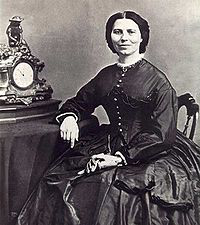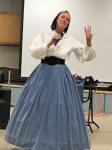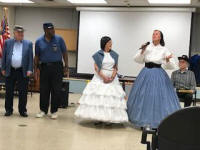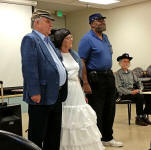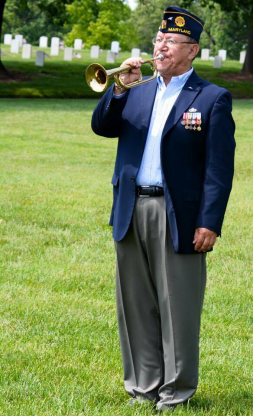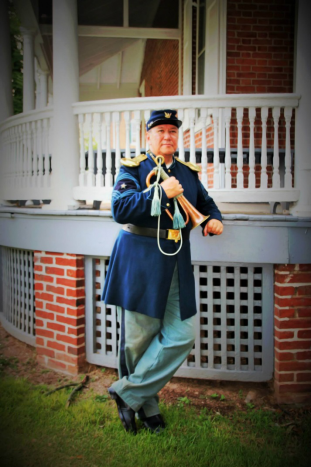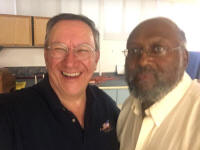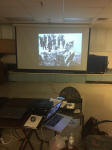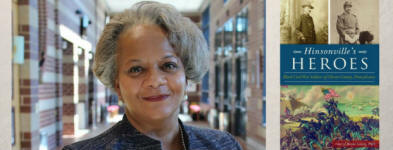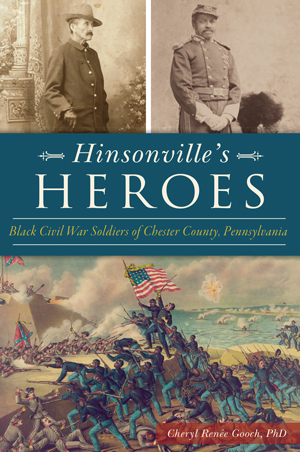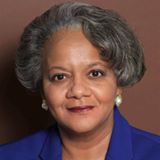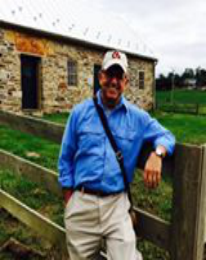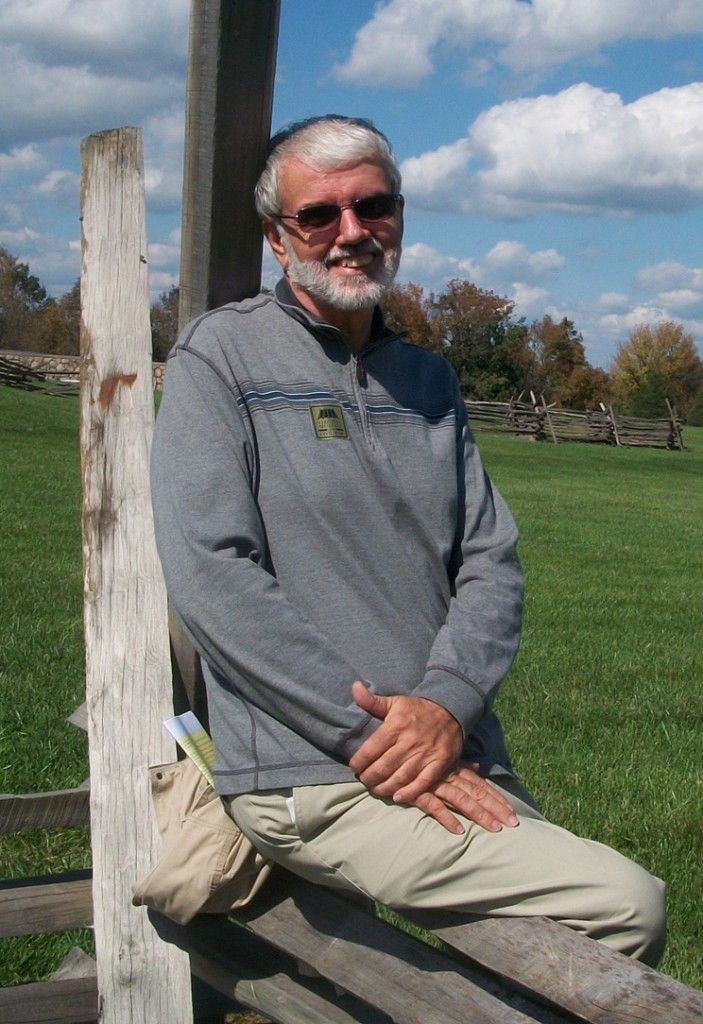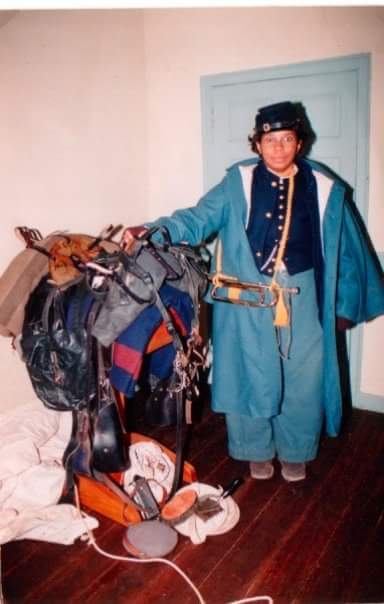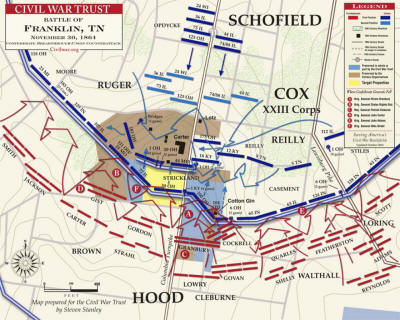- Online edition of newsletter -
Previous Meetings: 1999-2015 2016 2017 2018 2019 2020
|
The area in and around Washington, D.C. was a
hotbed of activity before, during and
immediately after the Civil War. Many history
minded people are aware of the political and
military ‘goings on” that directly affected the
nation as a whole. Few are aware of the lives of
everyday folk who, lived, worked and survived
those years.
National Archives researcher
Bryan Cheeseboro, with
introduce to the ordinary residents who
attempted to lead normal lives during
extraordinary times.
Bryan Cheeseboro is
a historian of the American past, primarily of
the Civil War Era. He works for the
National Archives and helps researchers find
their Civil War ancestors.
Cheeseboro is
also a board member of the Alliance to Preserve
the Civil War Defenses of Washington, who
annually commemorate the Battle of Fort Stevens
in Washington, DC every July. He is a
Civil War reenactor with the 54th Massachusetts
Company B and sometimes participates with other
reenacting units, including civilian reenacting.
And he is very proud to say he is a native of
Washington, DC.
Notes from the President December 2018
On behalf of our Board, I wish you all a Happy
and Blessed Holiday Season! Whether you
celebrate Christmas, Chanukah (Hanukkah),
Ashura, Bodhi Day, Kwanza or any other festival
of note, May Peace Be With You All!
Since it’s been less than two weeks since our
last meeting, there aren’t many updates. We are
still working to complete our arrangements for
our Annual Banquet in April, which will again we
held at Columbus Gardens on April 23, 2019.
Working with the Chesapeake Civil War
Roundtable, we will provide detailed information
as soon as our speaker is confirmed. It is hoped
that this event will enhance the public image of
both organizations and increase our membership.
U.S. National Archives employee and Civil War
re-enactor Bryan Cheeseboro will talk about the
lives of some of the ‘everyday people’ in the DC
metro area (including Baltimore) at the December
11 meeting. Remember, this is the 2nd Tuesday!!!
University of Maryland Baltimore County (UMBC)
History Professor Anne S. Rubin will speak on
her book
Sherman’s March and America on
January 22.
Freemasonry played an important role in the
lives of many Civil War men, from officers to
enlisted men. Charles Matulewicz,
Worshipful Master at the Palestine Masonic Lodge
will provide insight into wartime masonry at our
February 26 meeting.
Historian Dr. Paul Kahan will focus on the
Reconstruction period utilizing his latest book; The
Presidency of Ulysses S. Grant: Preserving the
Civil War's Legacy
for our March 26 meeting.
On May 28, History Professor and author Janet
Croon will speak on her recently edited and
annotated
A Son of Georgia: The Civil War Journals of
LeRoy Wiley Gresham, 1860-1865. Gresham was an
12 years old invalid in Georgia who
began keeping a journal in 1860—just before
secession and Civil War tore the country and his
world apart. There is an article on the new book
in
The Old Liner in
the August News Articles link at the bottom of
the page.
Here’s a recent email “thank you” that was sent
to our website. Thanks to Webmaster Nils Lehneis
for the information.
From: Robin Sharkey
Hi Nils!
I just wanted to write a quick note to let you
know how your page has helped my daughter
Madison!
Madison just finished a book about the Civil War
for her English class, and was assigned a
research paper about the era.
I had no idea where to begin to help her, but
luckily, we found your page:
http://bcwrt.nalweb.net/bcwrt_gallery.htm
It's been so helpful, and I wanted to personally
thank you for making it. There's a lot out there
to sort through, and it was nice to find so much
information in one place. Most of her sources
came from the information on your site, and I'm
positive her teacher will be impressed with her
thoroughness.
Along with your site, she also got a lot out of
this article:
https://onlinedegrees.bradley.edu/nursing/msn-fnp/nursing-and-medicine-in-the-civil-war/
It's all about nurses in the Civil War, and we
thought that your other readers would appreciate
it.
Madison thought she would help you by sending it
along. Would you consider adding it to your page
for her? Her project's due Monday, and I think
it would really impress her teacher if Madison
could show her that you added it.
I hope you're having a good week! I can't
believe the holidays are already here!
Best wishes,
Robin Sharkey
IMPORTANT REMINDER:
Remember, it’s time to renew your membership for
2018. Yearly
dues are $25.00 for an individual membership,
$35.00 for a family membership. Please give your
check to Ray Atkins or mail it to him using the
membership form found on our webpage.
(http://bcwrt.nalweb.net/default.htm.) We
are always looking for new members. Invite a
friend to our meetings. The BCWRT has many good
things happening. Please spread the word.
We
are always looking for new members. Invite a
friend to our meetings. The BCWRT has many good
things happening. Please spread the word.
Robert L. Ford,
President
Our December meeting was our 418th.
Our attendance was 15. We had one visitor, plus the wife of
the speaker. Our membership was 40. We had $1,857 in the bank,
and $75 to be deposited.
We were still waiting to hear from Doris Kearns Goodwin as to
whether she would be the speaker at our annual banquet (a joint
banquet with the Chesapeake Civil War Roundtable). Robert bought
“Civil War Minutes,” which consists of a series of brief
segments about various aspects of the war. We agreed to pay for
something that will boost viewership of our Facebook page.
Our speaker was Bryan Cheeseboro, a historian at the National
Archives and a reenactor in the 54th Massachusetts.
Mr. Cheeseboro, himself a Washington DC native, discussed the
DC area during the Civil War, as well as the lives of some of
the “everyday people” in the area.
In his discussion, Mr. Cheeseboro pointed out that the meaning
of the term “local” was very different during the war than it is
today. At that time, Baltimore wasn’t “local” to DC.
DC evolved a great deal from its creation in the 1790s and 1871,
when it assumed its present form. During the war, there was
“Washington City” as well as “Washington County”—which doesn’t
exist today. Washington City and Georgetown had a ring of
fortifications around them—including Fort Totten.
In 1860, the population of DC was 75,076, including 14,288
African Americans—78% of whom were free. DC was a “border
city,” and the population was divided in its sympathies. An
example of this split sentiment was Trinity Episcopal Church.
The congregation was divided, and the minister refused to pray
for a Union victory. The Union seized it as a hospital. The
congregation only found out it was being used for this purpose
when lumber was being unloaded during a service. Slavery was
abolished in 1862, and slaveowners sympathetic to the Union were
given financial compensation.
There were DC Confederate units that became part of Confederate
state units. Additionally, some officials joined the
Confederate government. On the other side, the 1st USCT
was organized in DC.
Mr. Cheeseboro discussed specific individuals in Washington and
neighboring areas. Mayor James G. Berret refused to take an
oath of allegiance to the U.S. and was forced to resign as a
result. His successor, Richard Wallach, opposed emancipation
and civil rights for African Americans. As a result, newly
enfranchised African Americans voted him out of office after the
war. John Summerfield Staples was hired by Abraham Lincoln to
be his paid substitute, serving for him in the army. |
Meeting: November 27, 2018
|
Constitution of the Confederate States of
America,
was adopted on March 11, 1861, and was in effect
from February 22, 1862, through the conclusion
of the American Civil War. This document, which
served as the legislative basis for the CSA, has
been the subject of several articles and books
since the end of the civil War.
University of Maryland Law Professor Mark A.
Graber,
along with Howard Gillman, have produced a
critical look at the document in the recently
published
The Complete American Constitutionalism, Volume
Five, Part I: The Constitution of the
Confederate States.
Our November meeting was our 417th.
Our attendance was 14. There was no
treasurer’s report.
Our speaker was Dr. Mark A. Graber, Regents
Professor at the University of Maryland Carey
School of Law. Dr. Graber spoke on the
Confederate Constitution. He and Howard Gillman
are the authors of
The Complete American Constitutionalism, Volume
Five, Part I: The Constitution of the
Confederate States.
Dr. Graber noted that approaches to the
Confederate Constitution tend to be either Lost
Cause or anti-Lost Cause. The Lost Cause
approach portrays slavery as being unimportant
in the Constitution and the creation of the
Confederacy. The anti-Lost Cause approach goes
in the other direction, not only acknowledging
the centrality of slavery but effectively saying
that anyone associated with the Confederacy in
any way was evil and deserves to be condemned.
The Confederate Constitution challenges the
common idea that constitutions are liberal
documents representing liberal values. The
document is mostly the U.S. Constitution. All
U.S. precedents were assumed to be valid unless
they contradicted Confederate principles. The
preamble states that: “We, the people of the
Confederate States, each State acting in its
sovereign and independent character…” It’s a
union of the states, not the people.
Unlike the U.S. Constitution, the Confederate
Constitution explicitly uses the word “slave.”
Slaves could not be banned in any Confederate
territory (although the Confederacy didn’t have
any territories at this point). Any citizen of
the Confederacy could take a slave into any
state. The Confederate Constitution also ended
the international slave trade (although the
Confederacy could import slaves from the U.S.).
South Carolina wanted to have the trade, but
Virginia and the rest of the Upper South did
not.
Confederates didn’t like political parties.
Elites governed the South and feared that
political parties could help ordinary people get
power. The Constitution only permitted the
president to serve one 6-year term.
Dr. Graber noted that the phrase “state rights”
did not define what really went on. In
important ways, the Confederacy was more
centralized than the Union. The Confederacy
enacted a draft before the Union did. Another
example is what happened when the Confederacy
contracted for whiskey. Virginia had banned the
use of farms to produce whiskey. But the
Confederate attorney general, pointing to the
U.S. Supreme Court decision
McCulloch v. Maryland,
said that a farmer’s contract with the
Confederate national government came first.
A Confederate Supreme Court was never
established. This was due to what Dr. Graber
called the “cycling of preferences.” Some
people wanted a Supreme Court that had the power
of judicial review, others wanted a Court
without this power, and still others did not
want one at all. None of these groups ever got
a clear upper hand, and as a result, no Supreme
Court was ever established.
In a legal sense, the Confederate Constitution
has no legacy. No U.S. court has ever treated
it as law, or even as “suggestions” for what law
should be.
Interestingly, Dr. Graber noted that in debates
concerning slavery and race, the rhetoric in the
Confederate Congress tended to be less extreme
and more sanitized than that in the U.S.
Congress during the same time. He attributed
this to the fact that Confederates took slavery
and white supremacy as a given, so there was
less cause to emotionally debate it.
|
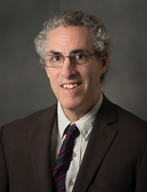
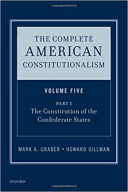
Notes from the President November 2018 BCWRT Community:
"Thursday Dec. 17th – Last night was very stormy – this morning
no better. Our house leaks all over, and our chimney works
badly, which make things rather uncomfortable."
The plight of the Civil War soldier during the cold months was
extremely difficult. Although there was some winter fighting
throughout the war, both armies generally set up winter camps in
anticipation of better weather. Fortunately, most of us don’t
have to face the cold that way, today. We are still working to complete our arrangements for our Annual Banquet in April, which will again we held at Columbus Gardens on April 23, 2019. Working with the Chesapeake Civil War Roundtable, we will provide detailed information as soon as our speaker is confirmed. . It is hoped that this event will enhance the public image of both organizations and increase our membership. The constitution is the backbone of any representative democracy. The Complete American Constitutionalism, Volume Five, Part I: The Constitution of the Confederate States is the new book by University of Maryland School of Law professor Mark A. Graber. He will discuss his work at the November 27 meeting. U.S. National Archives employee and Civil War re-enactor Bryan Cheeseboro will talk about the lives of some of the ‘everyday people’ in the DC metro area (including Baltimore) at the December 11 meeting. Rem ember, this is the 2nd Tuesday!!! University of Maryland Baltimore County (UMBC) History Professor Anne S. Rubin will speak on her book Sherman’s March and America on January 22. Freemasonry played an important role in the lives of many Civil War men, from officers to enlisted men. Charles Matulewicz, Worshipful Master at the Palestine Masonic Lodge will provide insight into wartime masonry at our February 26 meeting. Historian Dr. Paul Kahan will focus on the Reconstruction period utilizing his latest book; The Presidency of Ulysses S. Grant: Preserving the Civil War's Legacy for our March 26 meeting.
On May 28, History Professor and author Janet Croon will speak
on her recently edited and annotated
A Son of Georgia: The Civil War Journals of LeRoy Wiley Gresham,
1860-1865. Gresham was an 12 years old invalid in Georgia who
began keeping a journal in 1860—just before secession and Civil
War tore the country and his world apart. There is an article on
the new book in the
The Old Liner in
the August News Articles link at the bottom of the page.
NOTE: we have a new page on Facebook. Please visit
Baltimore Civil War Roundtable for
information and updates.
IMPORTANT REMINDER:
Remember, it’s time to renew your membership for 2018. Yearly
dues are $25.00 for an individual membership, $35.00 for a
family membership. Please give your check to Ray Atkins or mail
it to him using the membership form found on our webpage.
(http://bcwrt.nalweb.net/default.htm.) We
are always looking for new members. Invite a friend to our
meetings. The BCWRT has many good things happening. Please
spread the word.
We
are always looking for new members. Invite a friend to our
meetings. The BCWRT has many good things happening. Please
spread the word.
Robert L. Ford,
President
|
Meeting: October 23, 2018
|
During the Civil War, thousands of African
Americans sought freedom in Union-occupied
Alexandria. The Union Army was officially
responsible for their well-being, but provided
only the bare essentials, if that.
Two women--Harriet Jacobs and Julia
Wilbur--forged a unique, interracial partnership
to do more for freed people. In the 19th century
when women were supposedly confined to the home
“sphere,” they each came alone to a place where
they knew no one, and figured out how to make a
difference for other people—while also charting
new paths for themselves.
Both left primary sources that help us
understand their lives, as well as Alexandria
during this time. In the space between the
battlefield and the home front, their story
tells of a critical, but not-well-known side of
the Civil War.
Author Paula Tarnapol Whitacre will tell the
story of these two woman at the Baltimore Civil
War Roundtable meeting on October 23 at the
Parkville Senior Center,
8601 Harford Rd, Parkville, Md. 21234.
Ms Whitacre wrote a biography of Julia Wilbur’s
life,
A Civil Life in an Uncivil Time: Julia Wilbur’s
Struggle for Purpose
(Potomac Books, 2017) that a Kirkus reviewer
called “an
illuminating portrait of a remarkable
abolitionist working behind Union lines.”
Whitacre is a long-time freelance writer and
editor for the National Academy of Sciences,
National Institutes of Health, and many other
organizations. Previously, she worked for
The Washington Post and
the U.S. Information Agency as a Foreign Service
Officer.
She has lived in Alexandria since the mid-1980s
and is active in many local history
organizations. In addition to serving on the
board of the Civil War Roundtable of the
District of Columbia, she is president of
Friends of Alexandria Archaeology. |
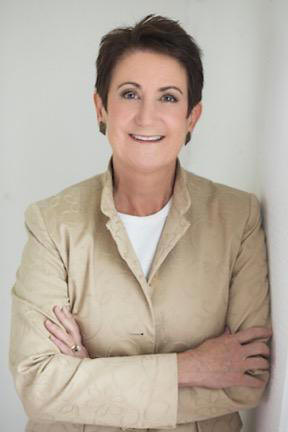 Paula Whitacre
Notes from the President October 2018
BCWRT Community:
The arrival of autumn reminds us of two historical events that
occurred in and around Maryland. On October 16, 1859, John Brown
led his Provisional Army from the Kennedy Farm in Maryland to
Harpers Ferry, Virginia in an action that historians list as one
of the major factors leading to the Civil War. On September 17,
1862, the bloodiest day in United States history took place at
the Battle of Antietam. There were an estimated 22,717
casualties (USA & CSA combined) during that single day of
action.
“Harriet Jacobs and Julia Wilbur: Allies and Friends in Civil
War Alexandria” will be the subject of the October 23
presentation by CWRT of D.C. Board Member and author Paula
Whitacre. The talk will be based on her book
A Civil Life in an Uncivil Time.
The Constitution of the Confederate States
is the new book by
University of Maryland School of Law professor Mark A. Graber.
He will discuss his work at the November 27 meeting.
U.S. National Archives employee and Civil War re-enactor Bryan
Cheeseboro will talk about the lives of some of the ‘everyday
people’ in the DC metro area (including Baltimore) at the
December 11 meeting.
University of Maryland Baltimore County (UMBC) History Professor
Anne S. Rubin will speak on her book
Sherman’s March and America on
January 22.
Freemasonry played an important role in the lives of many Civil
War men, from officers to enlisted men. Charles Matulewicz,
Worshipful Master at the Palestine Masonic Lodge will provide
insight into wartime masonry at our February 26 meeting.
Historian Dr. Paul Kahan will focus on the Reconstruction period
utilizing his latest book; The
Presidency of Ulysses S. Grant: Preserving the Civil War's
Legacy
for our March 26 meeting.
On May 28, History Professor and author Janet Croon will speak
on her recently edited and annotated
A Son of Georgia: The Civil War Journals of LeRoy Wiley Gresham,
1860-1865. Gresham was an 12 years old invalid in Georgia who
began keeping a journal in 1860—just before secession and Civil
War tore the country and his world apart. There is an article on
the new book in the current
The Old Liner in
the August News Articles link at the bottom of the page.
We are working with the Chesapeake Civil War Roundtable on
having a joint banquet in April. Contact is being made with
several top names in the Civil War community about their
availability. We will announce detailed information as soon as
things are finalized. It is hoped that this event will enhance
the public image of both organizations and increase our
membership.
NOTE: we have a new page on Facebook. Please visit
Baltimore Civil War Roundtable for
information and updates.
IMPORTANT REMINDER: We
are always looking for new members. Invite a friend to our
meetings. The BCWRT has many good things happening. Please
spread the word.
Robert L. Ford,
President
Pictures from Meeting
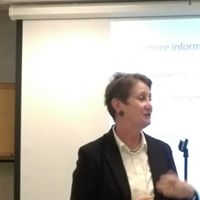
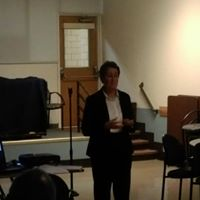  Minutes -
Our October meeting was our 416th.
Our attendance was 15. We also had one visitor (the
husband of the speaker). We had $1,960.31 in the bank, and
$27 to be deposited.
We are considering having our annual banquet next April
together with the Chesapeake Civil War Roundtable, and we
would like to have a major speaker. Robert contacted James
McPherson, but McPherson said he couldn’t do it. We might
have Doris Kearns Goodwin. The banquet would be at Columbus
Gardens, just as it was last year.
We discussed calling past members and inviting them to come
back to the Roundtable. We also discussed advertising at
the Senior Center.
Our speaker was Paula Whitacre. Ms. Whitacre’s presentation
was entitled “Harriet Jacobs and Julia Wilbur: Allies and
Friends in Civil War Alexandria.”
Harriet Jacobs was born a slave in Edenton, N.C. in 1813.
When she was around 15, her owner began making sexual
advances. In response, she began a relationship with a
prominent member of the white community and had two children
with him. When her owner sent her to his family’s
plantation in 1835, and she learned that her children were
going to be sent there as slaves, she ran away and went into
hiding for almost seven years. Finally, people sympathetic
to her got her to New York, where she found work as a nanny.
In 1852, she became legally free, and she was reunited with
her children when they were freed as well. She decided to
write a narrative and got Lydia Maria Child to help (she
needed to get a white woman to help her). Her book,
Incidents in the Life of a Slave Girl,
came out in the spring of 1861 and was well received.
Julia Wilbur was born into a large Quaker family in 1815.
When she was a young girl, her father became legally blind.
When she was about 13, he moved the family south of
Rochester. In 1844, she moved to Rochester to teach. She
taught at private and public schools and became involved in
the anti-slavery movement. She listened to Frederick
Douglass speak (Douglass published his paper
The North Star from
Rochester). She also met Harriet Jacobs. In 1858, her
sister Sarah died, and she moved back to the farm to take
care of Sarah’s daughter, two-year old Freda. She
effectively became Freda’s new mother. However, Freda’s
father reclaimed her, leaving Julia very hurt.
Alexandria was occupied by Union forces almost from the
beginning of the war. Escaped slaves began coming to the
city in large numbers, creating a refugee crisis. In 1862,
Julia went to Washington DC, where a freedmen’s relief group
asked if she would go to Alexandria to help the refugees.
From November 1862 to February 1865, she lived and worked
there. Harriet arrived in the city in January 1863. She
had written an article about the situation of freedmen in
Washington at the request of William Lloyd Garrison, and
realized she could make a difference in Alexandria.
The two women worked to improve the lives of the refugees in
any way they could. They protested mistreatment when they
saw it, but sometimes got in trouble for doing so. Both
women were heavily involved in giving away clothing to those
in need and sought to improve health care. They
successfully worked to avoid having orphans sent to the
smallpox hospital. When the war ended, both women went to Richmond, and spent 4 to 6 weeks there. However, they were not particularly well received by the army. Julia worked for the Freedmen’s Bureau, visiting homes to give tickets that could be exchanged for clothing and food. Harriet stayed in Alexandria until July 1865. She later ran a boarding house in Cambridge, Massachusetts, and subsequently moved back to DC. Julia was hired in 1869 by the Patent Office. She worked almost until her death in 1895. In the decades after the war, she and Harriet resumed their friendship. When Freda was 18 years old, she and Julia made contact again. Harriet’s later years in DC were difficult. She died in 1897. |
Meeting: September 25, 2018
|
Clara Barton was
working in the U.S. Patent Office in Washington,
DC when the Civil War began. Like many women,
she helped collect bandages and other
much-needed supplies, but she soon realized that
she could best support the troops by
going in person to the battlefields.
Throughout many major battles of the war, she
nursed, comforted and cooked for the wounded,
earning the nickname the “Angel of the
Battlefield.”
Award-winning actress and Smithsonian scholar,
Mary Ann Jung,
will bring Clara Barton to life at the next
BCWRT meeting on Tuesday, September 25 at the
Parkville Senior Center,
8601 Harford Rd, Parkville, Md. 21234 |
Mary Ann Jung as Clara Barton
Clara Barton
Notes from the President September 2018
BCWRT Community:
Hopefully, you and your loved ones have been doing OK with all
the extremely foul and dangerous weather occurring on the east
coast. Imagine how those living through wartime, mid 19th Century
USA/CSA dealt with those weather situations. It had to make a
hard life harder.
Many of us know something about Clara Barton. Learn more since
Ms Barton will ‘come to life’ when Smithsonian Scholar Mary Ann
Jung presents her award winning show “Clara Barton-Red Cross
Angel” at our September 25 meeting.
“Harriet Jacobs and Julia Wilbur: Allies and Friends in Civil
War Alexandria” will be the subject of the October 23
presentation by CWRT of D.C. Board Member and author Paula
Whitacre. The talk will be based on her book
A Civil Life in an Uncivil Time.
President
Our September meeting was our 415th.
Our membership was 40, and our attendance 18 (we also had one
visitor). We had $2,052.75 in the bank, and no outstanding
bills. The only future bills were speaker’s fees. The BCWRT’s
Facebook page was announced, and Robert mentioned some of the
suggestions of the Civil War Roundtable Congress.
Our speaker was Mary Ann Jung, an award-winning actress and
Smithsonian scholar. Ms. Jung returned to perform an encore
impersonation of Clara Barton. Clara Barton was born on
Christmas Day, 1821, the youngest of five children. Her mother
was an abolitionist, and her father, a Mason, had fought against
Indians. As a child, Barton was very shy. However, she learned
she was fearless when helping other people, and at the age of
seventeen she became a schoolteacher. She decided to open the
first free school in New Jersey (in the city of Bordentown). In
a single year, student enrollment went from six students to 600.
Nevertheless, Barton was kicked out of her job and replaced by
a man. She was so upset by this that she got sick. In 1855,
she moved to Washington D.C., and got a job in the Patent
Office. She was the first woman to have a significant clerkship
in the federal government. Men blew smoke in her face and
called her a slut with bastard children. Barton was finally
fired from the job.
When the Civil War began, there were few beds or supplies
available for wounded soldiers. Barton began to collect
whatever she could, including socks, soap, and blankets. She
accumulated about six tons of supplies. After initially being
rejected, she received a pass to travel with the troops. The
first battle she was at was Cedar Mountain. At Chantilly, she
nursed the wounded for three days straight without sleeping.
She was also at Antietam and other battles and became known as
“The Angel of the Battlefield.” She was never wounded, but once
a bullet killed a soldier she was caring for.
Near the end of the war, Lincoln gave Barton permission to
search for soldiers who were missing. She interviewed people,
made lists of the missing, and helped bury soldiers. She helped
turn Andersonville into a national cemetery. Following
Lincoln’s assassination, she assured slaves that the
Emancipation Proclamation was still valid. Eventually she broke
down from exhaustion, and her doctor sent her to Europe.
In Europe, Barton helped soldiers in the Franco-Prussian War.
She also became acquainted with the Red Cross, and when she
returned to the U.S., worked for America recognition of the
organization. She got in trouble because some people said the
Red Cross was only for wartime relief, but she persuaded the
government that the organization could respond to other
emergency situations as well. In 1881, when the American Red
Cross was founded, she became its first president—a position she
held until 1904.
Barton died on April 12, 1912—two days before the Titanic struck
an iceberg and three days before it sank. As a result, her
death was greatly overshadowed by the sinking in the news. She
never married, but Jung quoted her as saying: “…don’t think I
haven’t had my romances and affairs.” |
Meeting: August 28, 2018
|
PLEASE NOTE: We are back on our regular schedule
on fourth TUESDAY meetings.
The old adage says; “An army travels on its
stomach” One could also argue that supplies in
general were the backbone of every regiment
during any war. It could also be argued that
music- more specifically- regimental bands, were
key elements affecting movement and morale of
the armies in blue and gray.
On Tuesday, August 28, the BCWRT will take a
focused look at these bands when musician, Civil
War re-enactor and leader of the
Federal City Brass Band,
Jari Villenueva takes
a musical look at military unit bands and their
importance throughout the war. The meeting is at
the
Parkville Senior Center, 8601 Harford Rd,
Parkville, MD 21234. Jari Villaanuev is a graduate of the Baltimore Public School system and earned a Bachelor of Music Education degree in 1978 from the Peabody Conservatory of the Johns Hopkins University. In 1984 he received a
Master of Music degree from Kent State University, Ohio. He is also a spent 23 years with The USAF Band in Washington DC. He is considered the country’s foremost expert on military bugle calls, particularly the call of Taps which is sounded at military funerals. As a ceremonial trumpeter, Villanueva participated in well over
5,000 ceremonies at Arlington National Cemetery, served as an assistant drum major National Association for Civil War Brass Music, Inc., where he directs and leads The Federal City Brass Band and the 26th North Carolina Regimental Band, In addition, he is music director for the
National Civil
War Field Music School where students learn to play fife, drum and bugle
Thanks to the BCWRT for allowing me to attend
the recent Civil War Roundtable Congress at the
National Civil War Museum in Harrisburg, Pa. The
meeting of CWRT leaders from across the country
was exciting and informative. One of the key
concerns was how to increase membership and
attract younger members. I will give a partial
report at our August meeting with an action
report coming after our board member has to
opportunity to meet and filter the CWRTC
recommendations. By the way, a one day trip to
the museum would make a nice BCWRT outing.
Military bands where highly important to the
function and well-being of all units throughout
the Civil War. Trumpeter/ Bugler Jari
Villanueva, Musical Director for the Maryland
Defense Force and the Federal City Brass Band,
explore those bands in many aspects of the Civil
War.
Smithsonian Scholar Mary Ann Jung presents her
award winning show “Clara Barton-Red Cross
Angel” at our September 25 meeting.
“Harriet Jacobs and Julia Wilbur: Allies and
Friends in Civil War Alexandria” will be the
subject of the October 23 presentation by CWRT
of D.C. Board Member and author Paula Whitacre.
The talk will be based on her book
A Civil Life in an Uncivil Time.
The Constitution of the Confederate States
is the new book by
University of Maryland School of Law professor
Mark A. Graber. He will discuss his work at the
November 27 meeting.
U.S. National Archives employee and Civil War
re-enactor Bryan Cheeseboro will talk about the
lives of some of the ‘everyday people’ in the DC
metro area (including Baltimore) at the December
11 meeting.
University of Maryland Baltimore County (UMBC)
History Professor Anne S. Rubin will speak on
her book
Sherman’s March and America on
January 22.
Historian Dr. Paul Kahan will focus on the
Reconstruction period utilizing his latest book; The
Presidency of Ulysses S. Grant: Preserving the
Civil War's Legacy
for our March 26 meeting.
On May 28, History Professor and author Janet
Croon will speak on her recently edited and
annotated
A Son of Georgia: The Civil War Journals of
LeRoy Wiley Gresham, 1860-1865. Gresham was an
12 years old invalid in Georgia who
began keeping a journal in 1860—just before
secession and Civil War tore the country and his
world apart. There is an article on the new book
in the current
The Old Liner in
the August News Articles link at the bottom of
the page. We are in discussion with the Chesapeake Civil War Roundtable about a joint event where we can combine to bring in one of the top names in the Civil War community. They were to discuss the proposal at their August meeting. I’m certain we’ll have a report in September.
IMPORTANT REMINDER: We
are always looking for new members. Invite a
friend to our meetings. The BCWRT has many good
things happening. Please spread the word.
Robert L. Ford,
President |
Our August meeting was our 414th.
Our membership was 40, and attendance was 14. We had $2,217.75
in the bank, and no outstanding bills except for the August
speaker. Robert showed some pictures of archival material at
the National Civil War Museum in Harrisburg, where the Civil War
Roundtable Congress was held. We discussed the possibility of
taking a trip there. Robert said that one of the things the
congress emphasized was having a variety of Civil War
presentations, not just “blood and mud.”
Our speaker was Jari Villanueva. A U.S. Air Force veteran who
spent 23 years in the USAF Band in Washington D.C., Villanueva
spoke on Civil War music and bands.
He began by discussing the history of bands in the U.S. leading
up to the war. The term “band” was used to mean both military
and civic ensembles. The instruments used included oboes,
bassoons, clarinets, horns, and trumpets. Bands were originally
brought to the U.S. from Europe. Moravians who immigrated
brought their tradition of brass music played on trombones. The
first military musical organization in the United States was the
U.S. Marine Band, established in 1798. Later, percussion
instruments were introduced, including bass and snare drums, as
well as cymbals, a Turkish invention. Additionally, valves were
added to brass instruments. Around 1840-50, printed music
started to flourish. By the time the Civil War broke out, there
were thousands of bands in the United States.
To both Union and Confederate soldiers, music was very
important. There were three basic types of Civil War
music—music played by brass bands, field music (played by
fifers, drummers, buglers, and trumpeters), and folk music
(played in camp on violins and guitars, usually by untrained
troops).
Between April 1861 and the summer of 1862, the Union had
hundreds of bands. When the militia was federalized, their
bands came along with them. During the summer of 1862, about
two-thirds of the bands were cut. They were permitted to go
home and most did so. Others were enlisted as regular soldiers
and played on the side. In this way, many regimental bands
remained intact.
The most common selections played by the bands included John
Brown’s Body, Tramp, Tramp, Tramp, and Battle Cry of Freedom.
The bands played in church, in concerts during the evenings,
and at funerals. They also played at dances. Sometimes band
members had to load the weapons at executions and give them to
the soldiers. Contrary to what is widely believed, bands did
not lead soldiers into battle. Union and Confederate bands
sometimes “dueled” and played each other’s songs.
One of the war’s most notable bands was a Moravian one that
served with the 26th North
Carolina from April 1862 until the end of the war. They, like
other bands, also served as surgeon’s assistants. After the 26th suffered
enormous losses in the first day’s fighting at Gettysburg, they
joined with the 11th North
Carolina regimental band and played between Cemetery Hill and
Cemetery Ridge during gunfire. They were congratulated by
Robert E. Lee during the retreat from Gettysburg and were
captured at Five Forks while separated from their regiment. At
that point, they were sent to Point Lookout. Their instruments
were taken from them, although Sam Mickey managed to hide his
coronet. The band re-formed after the war.
After the Civil War ended, there were major changes in bands.
Patrick Gilmore, who is credited with the lyrics to “When
Johnny Comes Marching Home” (it was originally a Union song and
derived from an Irish tune) organized concerts with thousands of
performers. The standards he set were emulated by John Philip
Sousa. |
Meeting: Wednesday, July 25, 2018
|
PLEASE
NOTE: Due to a scheduling conflict, the July
meeting will be on Wednesday, July 25 rather
than our usual Tuesday!!
Here’s a link to our president’s review of the book (https://www.amazon.com/gp/customer-reviews/R3LMYDP8FFMAXT/ref=cm_cr_arp_d_rvw_ttl?ie=UTF8&ASIN=1467139467) 
 Our July meeting was our 413th. Our membership was 40, and attendance was 16. We had $2,207.75 in the bank, and no outstanding bills. Robert spoke about the 2018 Civil War Roundtable Congress, held on August 18th at the National Civil War Museum in Harrisburg, Pennsylvania. Our speaker was Dr. Cheryl Renée Gooch. Dr. Gooch spoke about her book Hinsonville’s Heroes: Black Civil War Soldiers of Chester County, Pennsylvania. The village of Hinsonville, which no longer exists, was located in Upper Oxford Township in Chester County, about six miles north of the Maryland border. The village was established by African Americans beginning in 1829. Many, if not most, of the inhabitants came from Cecil and Harford counties in Maryland. The name “Hinsonville” came from Emory Hinson, the first permanent resident. In 1843, the Hosanna African Union Methodist Protestant Church was founded. In 1854, John Miller Dickey, a white Presbyterian minister, co-founded Ashmun Institute along with some Hinsonville residents. The original purpose of the college was to train African American men to become missionaries in Liberia. In 1866, the college was renamed Lincoln University, and still exists today. Hinsonville’s residents were active in the antislavery movement. During the Civil War, 18 men from Hinsonville enlisted in the Union army. Six fought in the 54th Massachusetts. Two fought in the 22nd U.S.C.T., which led Lincoln’s funeral procession. One was in the 24th U.S.C.T, three in the 25th, two in the 41st, three in the 127th, and one in the 5th Massachusetts Cavalry. While the soldiers from Hinsonville had a high survival rate—16 of the 18 survived the war—most of the survivors spent their postwar lives in poverty. Many had difficulties because of their wartime injuries. In addition, the men often ran into serious problems concerning their pensions. Stephen J. Ringgold, a former slave, was born in Port Deposit and served in the 22nd U.S.C.T. In 1907, he applied for an increase in his monthly payment. He was told that he needed to provide documentation of his birth—even though he was separated from his parents when he was a child! He was also asked to give a physical description of his former owner. He wrote to his former owner’s daughter, asking for help. In the end, it took four years for his birthday of August 11, 1836 to be accepted. He died in 1913. Almost all the veterans had to hire attorneys, and doctors often minimized their suffering. Some of their wives and children were able to continue receiving pensions after they died. |
Cheryl Renee Gooch, PhD
Notes from the President 7.2018
I wish to thank all the members and our speaker Darlene Colon for being able to adjust to the last minute change of venue and attend the June meeting. Special thank go to the Rev. Tim Grayson, Rector of the Episcopal Church of the Messiah, and his staff for allowing us to meet in their fine edifice. Rest assured, we will take steps to avoid a repeat of that last minute drama. Also remember, our July meeting will be on Wednesday July 25, rather than our normal Tuesday. Founded by free Blacks from Maryland and located six miles above the Mason/Dixon Line, the small village of Hinsonville, Pennsylvania sent 18 men to serve the Union forces. On July 25, Dr. Cheryl Renee Gooch will introduce you to the Hinsonville’s Heroes whose impact on the United States is still being felt. Military bands where highly important to the function and well-being of all units throughout the Civil War. Trumpeter/ Bugler Jari Villanueva, Musical Director for the Maryland Defense Force and the Federal City Brass Band, explore those bands with a special focus of bans belonging to the USCT. Smithsonian Scholar Mary Ann Jung presents her award winning show “Clara Barton-Red Cross Angel” at our September 25 meeting. “Harriet Jacobs and Julia Wilbur: Allies and Friends in Civil War Alexandria” will be the subject of the October 23 presentation by CWRT of D.C. Board Member and author Paula Whitacre. The talk will be based on her book A Civil Life in an Uncivil Time. The Constitution of the Confederate States is the new book by University of Maryland School of Law professor Mark A. Graber. He will discuss his work at the November 27 meeting. U.S. National Archives employee and Civil War reenactor Bryan Cheeseboro will talk about the lives of some of the ‘everyday people’ in the DC metro area (including Baltimore) at the December 11 meeting. University of Maryland Baltimore County (UMBC) History Professor Anne S. Rubin will speak on her book Sherman’s March and America on January 22. Historian Dr. Paul Kahan will focus on the Reconstruction period utilizing his latest book; The Presidency of Ulysses S. Grant: Preserving the Civil War's Legacy for our March 26 meeting. We are in discussion with the Chesapeake Civil War Roundtable about a joint event where we can combine to bring in one of the top names in the Civil War community. We will keep your abreast as actions developed. IMPORTANT REMINDER: We are always looking for new members. Invite a friend to our meetings. The BCWRT has many good things happening. Please spread the word.
Robert L. Ford, |
Meeting: June 26, 2018
Meeting: May 22, 2018
|
June 1863. The Gettysburg Campaign is underway.
Robert E. Lee’s Army of Northern Virginia is
pushing northward through the Shenandoah Valley
toward Pennsylvania, and only one significant
force stands in its way: Maj. Gen. Robert H.
Milroy’s Union division of the Eighth Army
Corps, in the vicinity of Winchester and
Berryville, Virginia. What happened next is the
subject of the provocative new book
The Second Battle of Winchester: The Confederate
Victory That Opened the Door to Gettysburg, June
13-15, 1863.
Today, the Second Battle of Winchester is
largely forgotten. But in June 1863, the
politically charged front-page news caught
President Lincoln and the War Department by
surprise and forever tarnished Milroy's career.
The beleaguered Federal soldiers who fought
there spent a lifetime seeking redemption,
arguing their three-day "forlorn hope" delayed
the Rebels long enough to allow the Army of the
Potomac to arrive and defeat Lee at Gettysburg.
For the Confederates, the decisive leadership on
display outside Winchester proved an illusion
that masked significant command issues buried
within the upper echelons of Stonewall Jackson's
former corps that would only make themselves
known in the earliest days of July on a
different battlefield. Award-winning authors Eric J. Wittenberg and Scott L. Mingus Sr. combined their researching and writing talents to produce the most in-depth and comprehensive study of Second Winchester ever written. Scott L. Mingus, Sr. will give a presentation on this battle at the BCWRT May 22 meeting.
Scott L. Mingus, Sr.
is a scientist and executive in the paper and
printing industry, as well as the author of
several books and magazine articles on the Civil
War, including some that deal primarily with
York County during the Gettysburg Campaign. His
2013 work,
Confederate General William Extra Billy Smith:
From Virginia's Statehouse to Gettysburg
Scapegoat
won the Nathan Bedford Forrest History Book
Award and the Dr. James I. Robertson, Jr.
Literary Prize Award. His Cannonball blog
presents stories and anecdotes from the war
years, as well as announcing local Civil War
events of the modern day. Together with his wife
Debi, he publishes
CHARGE!,
the leading international magazine for Civil War
miniature wargaming. They reside in York, Pa. |
Scott L. Mingus, Sr.
Our May meeting was our 411th.
As of May 22nd, our membership was 50 (we had one new member),
and we had $2,721.72 in the bank. We had no outstanding bills
except for paying the May speaker.
Our speaker was Scott L. Mingus Sr. Mingus spoke on the Second
Battle of Winchester, which took place on June 13-15, 1863. He
and Eric Wittenberg are the authors of a book on the battle
entitled
The Second Battle of Winchester: The Confederate Victory that
Opened the Door to Gettysburg.
For one week, Second Winchester dominated newspapers in the
North. The last two weeks of June, and the first two of July,
was summer harvest time in south-central Pennsylvania and
Maryland. Lee timed his invasion to match the harvest.
Southern PA was die-hard Democratic Copperhead country, and
this also encouraged Lee—he thought the Copperheads would force
the Union to the negotiating table. Additionally, he wanted to
take the pressure off Vicksburg, and to threaten Union railroads
as well as supply and communication routes.
Between late December 1862 and New Year’s Day 1863, Robert
Milroy marched into Winchester with the 2nd Division
of VIII Corps. He was responsible for defending the town from
Confederate attacks. Few of the troops in Milroy’s command had
been in combat. He took over forts that had been built to the
northwest of the town and set about improving them.
Throughout the winter, there were small Confederate cavalry
raids. However, after capturing prisoners in mid-June, it
became clear that they were facing the Army of Northern Virginia
(the Second Corps of the ANV), not just independent bands of
cavalry. Lincoln ordered an evacuation of Winchester, but
Milroy decided to stay and fight (it was hard to get a telegram
from Baltimore to Winchester at the time).
On the 13th,
the Confederates approached in 3 columns. Rodes’ division went
for Berryville, Early’s along the Valley Pike near Kernstown,
and Johnson’s up the Front Royal Pike. The Union forces fell
back, but fought surprisingly well, given that most of the men
had never fought before. The Taylor Hotel and the whole town of
Winchester became a hospital. June 14-15 were great days for
Ewell. On the 14th he
successfully flanked Milroy. Union counterattacks failed; an
artillery duel lasted until 10 pm.
On the 15th,
Milroy withdrew from Winchester but left the artillery! The
artillery pieces were used by the Confederates at Gettysburg.
He left the wounded behind as well. The route to Harper’s
Ferry was blocked by Confederates, so an attack was launched
against the Charles Town Road railroad bridge to open the way.
This failed, and Milroy left as the end approached. Most of
his command was lost. Perhaps 4,000 Union soldiers surrendered
in 15 minutes. Most of the captured were later taken to
Andersonville, and roughly a third of them died there.
Milroy went home and petitioned to be put back in the war. In
May 1864, he was sent to guard railroads in Tennessee. In
December, he defeated a Confederate force which included Nathan
Bedford Forrest’s cavalry.
While the Second Battle of Winchester was a Confederate victory,
it was also a fiasco for the Confederates in that it made them
believe that Ewell could operate on his own. Milroy and his men
believed they saved Pennsylvania by delaying the Confederates at
the three-day battle.
|
Meeting: April 24, 2018
|
Annual Banquet April 24: 4301 Klosterman Ave., Baltimore, MD. >> Banquet Flyer Directions >> http://columbusgardens.com/id82.html Meeting April 24, 2018 Note: Due to illness, Ed Bearss will not be able to speak at our April 24 banquet. I spoke with Ed and he is home and improving. He sends his regards to one of his favorite roundtables. The Civil War Trust’s (CWT) Frank Deluca has graciously stepped in at the last minute. The Civil War Trust is a nonpartisan, nonprofit organization devoted to the preservation of America’s hallowed battlegrounds. Although primarily focused on the protection of Civil War battlefields, the Trust also seeks to save the battlefields connected to the Revolutionary War and War of 1812. Through educational programs and heritage tourism initiatives, the Trust seeks to inform the public about the vital role these battlefields played in determining the course of our nation’s history. Our banquet speaker Frank Deluca, will address the mission and goals of the CWT and will discuss and display some of the accomplishments of this preservation organization. Frank DeLuca is the Senior Vice President for the Civil War Trust responsible for building constituent relations and leading efforts for major and large gifts. He has been at the Trust for 11 years. Prior to the Trust, Frank was Vice President for Advancement for 17 years at Mount Saint Mary’s University and led a campaign to raise more than $70 million. Frank has a bachelor’s and master’s degree from Mount Saint Mary’s. He was awarded the prestigious President’s Medal in 2005 by his alma mater. Frank has also worked in Development at Johns Hopkins University, the University of Maryland and the College of Notre Dame. He has two sons and seven grandchildren. He and his wife, Kerrie, live in Baltimore in the Guilford area.Minutes...
Our April meeting, our 410th,
was our annual banquet. Attendance was 34.
Our speaker was Frank DeLuca, Senior Vice
President for the Civil War Trust. DeLuca was
filling in for Ed Bearss, who had to cancel due
to illness. DeLuca discussed the activities and
successes, past and present, of the Civil War
Trust. In thirty years, the organization has
raised 370 million dollars, and saved almost
50,000 acres of land from development. It has
saved land at 134 battlefields in 24 states.
Three years ago, the National Park Service asked
for help in preserving Revolutionary War and War
of 1812 battlefields. Since then, the
organization has saved land at a number of
Revolutionary War sites, including 18 acres at
Princeton, some at Lexington and Concord, and
some at Brandywine. The most extensive activity
is taking place in South Carolina, where 60
sites are being preserved, and an attempt is in
the works to create a Liberty Trail from
Charleston to King’s Mountain. The first
interpretative place will be in Camden. DeLuca
stated that the Trust believes the Revolution
was won in South Carolina.
Every year, the Trust lobbies for $10 million
from the government. The organization has gone
through several names—it began as the
Association for the Preservation of Civil War
sites, then became the Civil War Preservation
Trust, then the Civil War Trust. DeLuca stated
that on May 8th,
there would be yet another name change—although
he could not say what the new name was (the name
is “The American Battlefield Trust.”)
DeLuca addressed the question of why the
organization does the work it does. He gave two
reasons: 1.) Soldiers put their lives on the
line for what they believed, and deserve to be
remembered, and 2.) history is not taught in the
schools. He noted that last year, the Civil War
Trust website had nine million visitors. The
organization’s activities include a Field
Education Program, which gives money to schools
to make trips to battlefields. 20,000 children
have visited battlefields as a result. There is
also a “Generations” project that saved Lee’s
headquarters at Gettysburg, and stopped the
building of casinos.
|
Frank Deluca
Notes from the President 4/2018
BCWRT Community:
Tuesday, April 24, is the date of the BCWRT Annual Banquet. We
were scheduled to have Ed Bearss as our speaker. Unfortunately,
Ed is ill and had to cancel. Fortunately, we have secured Civil
War Trust Senior Vice President Frank Deluca fill the gap. He
will speak on the work and accomplishments of the Civil War
Trust. Remember, our
new banquet venue is the Columbus Gardens, 4301 Klosterman Ave.,
Baltimore, MD. 21236. Klosterman Ave. intersects US Route 1
(Belair Rd) about a mile north of Rossville Blvd. The cocktail
hour begins at 6 p.m. with dinner being served at 7 p.m. Tickets
are $35.00. Please see the flyer located on the website. Please
urge your friends to attend and don’t forget to purchase your
own tickets.
The Second Battle of Winchester: The Confederate Victory That
Opened the Door to Gettysburg June 13-15, 1863
is the book on which author Scott
L. Mingus, Sr. will speak at our May 22 meeting. History Interpreter Darlene Colon will appear as the important, but, not well known Civil War figure Lydia Hamilton Smith. This will be our June 26 meeting.
Founded by free blacks from Maryland and located six miles above
the Mason/Dixon Line, the small village of Hinsonville,
Pennsylvania sent 18 men to serve the Union forces. On July 24,
Dr. Cheryl Renee Gooch will introduce you to the
Hinsonville’s Heroes whose
impact on the United States is still being felt.
Our speaker for the August 28 meeting hasn’t been confirmed. The
information will be distributed as soon as we receive
confirmation.
Smithsonian Scholar Mary Ann Jung presents her award winning
show “Clara Barton-Red Cross Angel” at our September 25 meeting.
IMPORTANT REMINDER:
Remember, it’s time to renew your membership for 2018. Yearly
dues are $25.00 for an individual membership, $35.00 for a
family membership. If you have already paid, Ray Atkins will
have your membership card at out next meeting. We
are always looking for new members. Invite a friend to our
meetings. The BCWRT has many good things happening. Please
spread the word.
Robert L. Ford,
President |
Meeting: March 27, 2018
Meeting: February 27, 2018
|
It is estimated that more than 400 women
disguised themselves as men in order to serve
both sides of the military during the American
Civil War. One of the more unique was Maria
Lewis who double disguised herself while serving
as a trooper in the 8th New
York Calvary Regiment (Rochester Regiment).
While seeing plenty of action, including
fighting in the 2nd Battle
of Winchester, Maria Lewis was an
African-American woman who masqueraded as a
white male in order to serve with the 8th.
Dr. Anita L. Henderson will
bring Maria Lewis to life during her BCWRT
presentation. Dr. Henderson has been working on
a 20+ yearlong research project on Maria Lewis,
which has been presented at the Society of Women
in the Civil War in 2005 and 2015, a Company of
Military Historians meeting and other local
groups. She is currently in the process of
preparing her talk for publication in the
Company of Military Historians journal and
another Civil War magazine. Her future plans
include a young people’s historical novel on
Maria Lewis.
Anita L. Henderson is
a native of Chicago, IL, who attended Wellesley
College and Howard University College of
Medicine. She currently is a dermatologist
practicing with Anne Arundel Dermatology in
Columbia, MD.
Her earliest passions have been horses and
history, learning how to ride at the age of 7,
riding English and Western, participating in
Western and English horseshows, jumping, trail
riding all over the US, herding cows out west,
foxhunting, carriage driving, cowboy mounted
shooting and mounted Civil War cavalry. She has
ridden in Ireland, Portugal and all over the US.
Her passion for history was stoked by both
parents, her mother a teacher and her father a
former WWII veteran who had been a drill
instructor and quartermaster battalion clerk.
She grew up listening to her parents and other
family members’ stories and started to read and
study history voraciously. Twenty years ago, the two passions merged when she became interested in Civil War living history and was lucky enough to meet authentic living historians who wanted to interpret the war and its participants accurately with regard to knowledge, uniform and clothing and interpretation. She currently interprets both a military and civilian impression. She is a mounted cavalry bugler currently riding with the 13th VA Cavalry, Co. H., Light Sussex Dragoons and does an enslaved/free black woman who is a cook and does open fire and hearth cooking using period recipes and implements. She also does an enslaved housekeeper interpretation as well. She is a long time member of the Atlantic Guard Soldiers’ Aid Society one of the most authentic civilian living history groups in the country She recently became a member of the Sons and Daughters of Ham who are an authentic, black civilian group. She is also a member of the Company of Military Historians. She has also done background artist work in a variety of historical documentary, independent and Hollywood films including; Wicked Spring, No Retreat From Destiny, The Unmasking of Sarah Edmonds, Racing the Times, A History of Horse Racing in Maryland-PBS, Civilians Desolate, Civilians Free, Fredericksburg NBP film and Gods and Generals. |
Anita Henderson Minutes of meeting
Our February meeting was our 408th.
Our attendance was 23. We had $1,879 in the bank ($1,964,
counting deposits). Our membership was 22 (this doesn’t include
people who haven’t paid their dues).
In March, Bob O’Connor will give a “first-person” presentation
on Ward Hill Lamon, Lincoln’s friend and self-appointed
bodyguard.
April is our annual banquet with Ed Bearss. Ed will be speaking
on Reconstruction. The banquet will be held at Columbus
Gardens, on Belair Rd. Costs are $35 per person. The banquet
is April 24th.
In May, Scott L. Mingus Sr. will speak on his book:
The Second Battle of Winchester: The Confederate Victory That
Opened the Door to Gettysburg June 13-15, 1863.
In June, Darlene Colon will impersonate Lydia Hamilton Smith.
Our president, Robert Ford, noted that we are currently trying
to get pictures of meetings in the newsletter. Any volunteers
to take the pictures are welcome.
Robert also showed an interesting video entitled “From the Slave
House to the White House.” The video discussed two relatives of
former First Lady Michelle Obama who served in the Civil War.
Jerry Sutton/Suter, who joined the 55th Massachusetts,
was the stepfather of Obama’s great-grandmother, and Caesar
Cohen, a great-great grandfather of Obama’s, enlisted in the 128th U.S.
Colored Troops.
Our speaker was Anita Henderson. Ms. Henderson spoke on “The
Search for Maria Lewis, Black Female Trooper of the 8th New
York Cavalry.” Henderson, a historical reenactor, found out
about Lewis from the diaries of Julia Wilbur, a Quaker.
The 8th was
formed in Rochester and served in the Army of the Potomac
throughout the war. At Harper’s Ferry, it was one of a small
group of units to escape by riding through Confederate lines.
At first, Henderson believed that Lewis had been born free. In
2014, however, she learned that another Wilbur diary had been
found, and this one provided more information. It turned out
that Lewis was an escaped slave from Albemarle County, Virginia.
She joined the regiment in August or September 1863, using the
alias “George Harris.” Only a teenager at the time, she loved
the army, and fought like everyone else in the regiment. She
stayed with the officers, away from the enlisted rank and file.
The officers knew that she was female, but the enlisted men did
not. She was at the battle of Waynesboro and came to Washington
D.C.
It should be noted that during the Civil War, medical
examinations for those joining the military were very
perfunctory at best. Because of this, hundreds of women were
able to enlist and fight on both sides. Lewis could have
credibly passed herself off as a boy (teenagers matured more
slowly then) and was probably light-skinned. Her riding ability
was unusual for a slave girl—this may mean that she had special
privileges on her plantation. Additionally, “George Harris” was
a character in
Uncle Tom’s Cabin—this
suggests she may have been literate. |
Meeting: January 23, 2018
|
Our speaker will be Dr. Lester Brooks.
He will speak on the November 1864 Battle of
Franklin, Tennessee.
Notes from the President 1/2018
BCWRT Community:
Happy New Year! I hope and trust that entered 2018 in good health and in fine spirits. We will embark on our 2018 journey on January 23 when Chesapeake Civil War Roundtable Program Coordinator and Anne Arundel Community College Professor Dr. Lester Brooks presents a program on the Battle of Franklin. This November 1864 clash was one of the most significant actions during the later phase of the Civil War. The meeting begins at 7:30 p.m.
Usually disguised as males, many women, on both sides, took up arms during the war. On February 27 historian and reenactor Anita Henderson will introduce you to one special female horse soldier. Author, historian Bob O’Connor will have a ‘first person” presentation on Ward Hill Lamon, Lincoln’s friend and self-appointed bodyguard, on March 27.
Last September, we thought our April 24 Annual Banquet was basically arranged. Since then, the event has turned into an adventure. First our location, Parkville Heritage Gardens ceased operation (we will announce a new location in the near future). Then, to make matters worse, our scheduled speaker, noted author and historian Edward Bonekemper , died last month (Requiescat in pace). Fortunately, we have been able to schedule National Park Service Historian Emeritus, Ed Bearss, to be our speaker.
On May 22, author Scott L. Mingus Sr. will speak on his book, The Second Battle of Winchester: The Confederate Victory That Opened the Door to Gettysburg June 13-15, 1863.
IMPORTANT REMINDER: Remember, it’s time to renew your membership for 2018. Yearly dues are $25.00 for an individual membership, $35.00 for a family membership. If you have already paid, Ray Atkins will have your membership card at out next meeting. We are always looking for new members. Invite a friend to our meetings. The BCWRT has many good things happening. Please spread the word.
Robert L. Ford, President |
Click picture to enlarge See new link in Gallery - Intelligence in the Civil War Archaeology Lecture/Sunday, January 28, 2018 at 1 PM. Abraham Lincoln and John Wilkes Booth, Historian Dave Taylor will be addressing the Archeological Society of Maryland, Central Chapter group with some of the lesser known stories of the Lincoln assassination saga that follow an archaeological theme (i.e. stories that involve digging and discovery) in his talk entitled "Unearthed Stories of the Lincoln Assassination". The talk will be held at 1:00 p.m. on Sunday, January 28, 2018 at the Natural History Society of Maryland located at 6908 Belair Road, Baltimore, MD 21206. The public is welcome. The event is free. The Natural History Society of Maryland at 6908 Belair Road, lecture room has a capacity of 175 persons. For additional information; contact Stephen Israel at Minutes from January Meeting
Our January meeting was our 407th.
Our attendance was 17 (not including 3 visitors). We had
$2,053 in the bank, and no outstanding bills. We settled on a
restaurant for the banquet—Columbus Gardens, on Belair Rd.
Costs will be $35 per person, instead of $30. The banquet is
April 24 and features the incomparable Ed Bearss. Ed will be
speaking on Reconstruction.
In February, Anita Henderson will be speaking on cavalrywoman
Maria Lewis.
In March, Bob O’Connor will give a “first-person” presentation
on Ward Hill Lamon, Lincoln’s friend and self-appointed
bodyguard.
In May, Scott L. Mingus Sr. will speak on his book:
The Second Battle of Winchester: The Confederate Victory That
Opened the Door to Gettysburg June 13-15, 1863.
In June, Darlene Colon will impersonate Lydia Hamilton Smith.
Jefferson Davis had replaced Joseph E. Johnston with John Bell
Hood as commander of the Army of Tennessee. Hood had written
letters undermining Johnston. Robert E. Lee, however, was less
than enthusiastic about the change of generals. Sherman said
that he could accurately predict Johnston’s movements because
Johnston, unlike Hood, was a sensible man. While Sherman was
conducting his March to the Sea, instead of pursuing him, Hood
decided to march into Tennessee, with the aim of eventually
joining Lee.
George H. Thomas was gathering troops in Nashville. Sherman
sent him XXIII Corps, under John Schofield (a classmate of
Hood’s at West Point), to join him, as well as IV Corps, under
David Stanley.
At Spring Hill, the Confederates allowed Schofield to march
through largely unmolested. The reason for this is still not
totally clear. At 4:30 A.M. on November 30, 1864, Schofield
arrived at Franklin with Jacob Cox. He ordered Cox to hold Hood
back so the supply wagons could cross the river. The army
deployed on both sides of the Columbia Pike.
Hood had around 25,000 men. Dr. Brooks addressed the question:
Why did he fight at Franklin when he didn’t have to? Nathan
Bedford Forrest said to flank the Federals, rather than do a
frontal assault. But Hood believed he couldn’t let the Federals
get into Nashville, that they would see any flanking movements,
and that if directly attacked, they would break.
The assault began at 4 P.M. The attackers suffered terrible
casualties. They faced not just artillery and small arms fire
but, in various places, repeating rifles, bushes, and
breastworks six feet high. Francis Cockrell’s brigade found a
gap and went through it, only to run into two Napoleons. Two
sounds were heard—cannon fire and then the crushing of bones.
On the Union side, George Wagner deployed way in front of the
rest of the line. He eventually had to pull back, and in the
process many of his men were victims of “friendly fire” directed
at the advancing Confederates.
The Confederates eventually broke a 200 yard hole in the line.
Emerson Opdycke’s brigade slammed in to close the gap. There
were about 5,000 men from both sides fighting hand to hand
around the backyard of the Carter House (the house belonged to
Fountain Carter). The hole was ultimately plugged. Fountain’s
son, Tod, was shot in the head and died in his own living room.
Five Confederate generals were killed outright in the battle,
including Hiram Granbury and Patrick Cleburne, and one—John C.
Carter—was mortally wounded. Dr. Brooks said that the death of
Granbury “shakes me up.” When Granbury was killed, according to
reports, he literally sank to his knees. At midnight, Hood said that he would attack in the morning, but this never took place. Incredibly, he believed he won the battle! His men were not fooled, however. The official casualty figures are quite lopsided—2,326 Union casualties to 6,252 Confederate (as always in Civil War battles, these figures can not be presumed to be 100% accurate). Outside the Carter House, there was a pile of limbs six feet tall. Hood went on to lead the Army of Tennessee at the battle of Nashville, another disastrous Confederate defeat. He was replaced in January 1865. |
Previous Meetings - See what you missed by not being a member!
Join the Baltimore Civil War Roundtable to receive the complete edition of "The Old Liner"!

_small.jpg)

